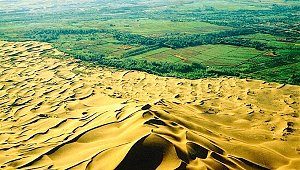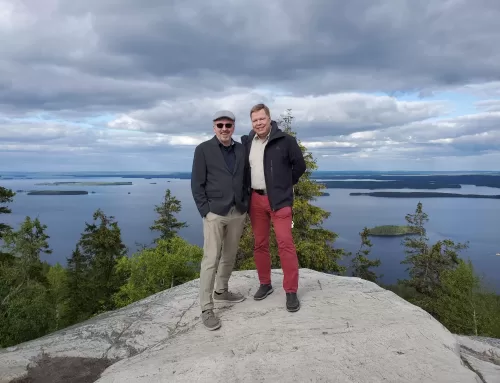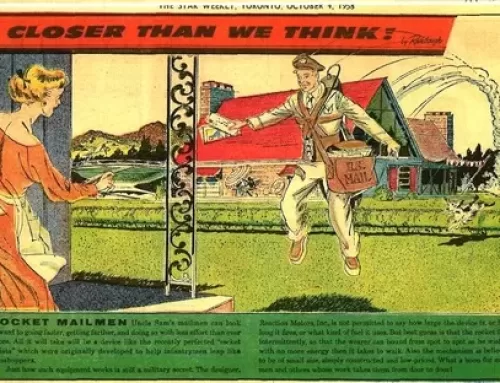 With the fast pace of modern technology, it’s no surprise that serious attention has been focused on how it might be applied to reclaiming some of the millions of square miles of non-polar desert which comprise approximately 13% of the Earth’s dry land surface. It’s not a new idea, but previous attempts have been hampered by the lack of reliable water sources to sustain new plantings. Yet this may be changing. The expense of desalinating seawater has fallen – at least, for locations near a coast – and the capability exists now of extracting water directly from even the driest of desert air. Importantly, both these methods avoid diversion of the already stressed existing groundwater supplies. With water available, a desert region could be methodically planted, beginning from its green fringe and working outward. Such a process may at some point be automated, according to a Dutch engineer writing in 2015: in the future, robots can be developed that will not only grow plants, but also maintain and monitor the new growth as it stabilizes and gains a foothold at the new edge of the desert.
With the fast pace of modern technology, it’s no surprise that serious attention has been focused on how it might be applied to reclaiming some of the millions of square miles of non-polar desert which comprise approximately 13% of the Earth’s dry land surface. It’s not a new idea, but previous attempts have been hampered by the lack of reliable water sources to sustain new plantings. Yet this may be changing. The expense of desalinating seawater has fallen – at least, for locations near a coast – and the capability exists now of extracting water directly from even the driest of desert air. Importantly, both these methods avoid diversion of the already stressed existing groundwater supplies. With water available, a desert region could be methodically planted, beginning from its green fringe and working outward. Such a process may at some point be automated, according to a Dutch engineer writing in 2015: in the future, robots can be developed that will not only grow plants, but also maintain and monitor the new growth as it stabilizes and gains a foothold at the new edge of the desert.
One welcome benefit of reforesting a great desert such as the Sahara would be in the international cooperation it could foster. It’s happened before: nations from Senegal in the west to Eritrea in the east have coordinated efforts over the last ten years to contain the further spread of the Sahara southward. However, much of the work, done by hand, was very labor-intensive. Perhaps the use of autonomous machines for these tasks would supplant the low-skill human workers, but it would also create the opportunity for the nations to train and employ the many technicians needed for the robots, which will likely be there for a long time. Perhaps historical rivalries between the regions could be channeled productively into competition for which country or district can average the greatest annual reclamation acreage from sand to farmland or forest.
Yet the slow expansion of plants will mean not only opportunities, but raise some difficult questions, too. How much of the new growth will be allocated to forest use and how much to farmland? How will wildlife be managed, as animals move into the new areas, especially as new waterholes form and existing oases expand? Will existing Saharan mammals (which tend to be small, reducing their surface area water loss) be subject to overwhelming predation by larger animals moving in with the new treelines? In Africa, as in many other less-developed areas of the world, land is often unregistered and ownership unclear. Will it be a foregone result that the newly productive land will routinely fall into the hands of cronies working for the local Big Men?
In any case, as the effort gains momentum, education will be necessary for the local indigenous population in interacting with the re-greening robots. After all, the large-scale use of such autonomous systems could be thought of as introducing an entirely new species to the local ecosystem. Like natural organisms, the robots would be creatures deeply connected to their environment, and they would remain in a re-forested location for probably many years – if not indefinitely – to monitor and care for the new growth, to assure its success. Caution may be needed as their activities begin to encrouch on the traditional lands and nomadic culture of the Berber and Bedouin peoples of North Africa.
Finally, in evaluating the progress of such efforts, the global ecological implications shouldn’t be ignored. Existing evidence has found that the forest of the Sierra Nevada region of the US receive valuable nutrients in dust originating from the Gobi desert. Similarly, the Amazon rainforest benefits from dust blown across the Atlantic from the Sahara. A shift in weather patterns above and around new-forested areas will likely also result, with the possibility of corresponding climate change elsewhere.
As we can see, leveraging technology to change the environment, ostensibly for the better, can be easily visualized, but to really make it plausible, one must be ready to consider and address the social, political, and wider environmental aspects as well. — Kurt Callaway
(image from https://desertification.wordpress.com/2016/09/09/pan-african-effort-to-plant-trees-along-the-edge-of-the-sahara-desert/)



